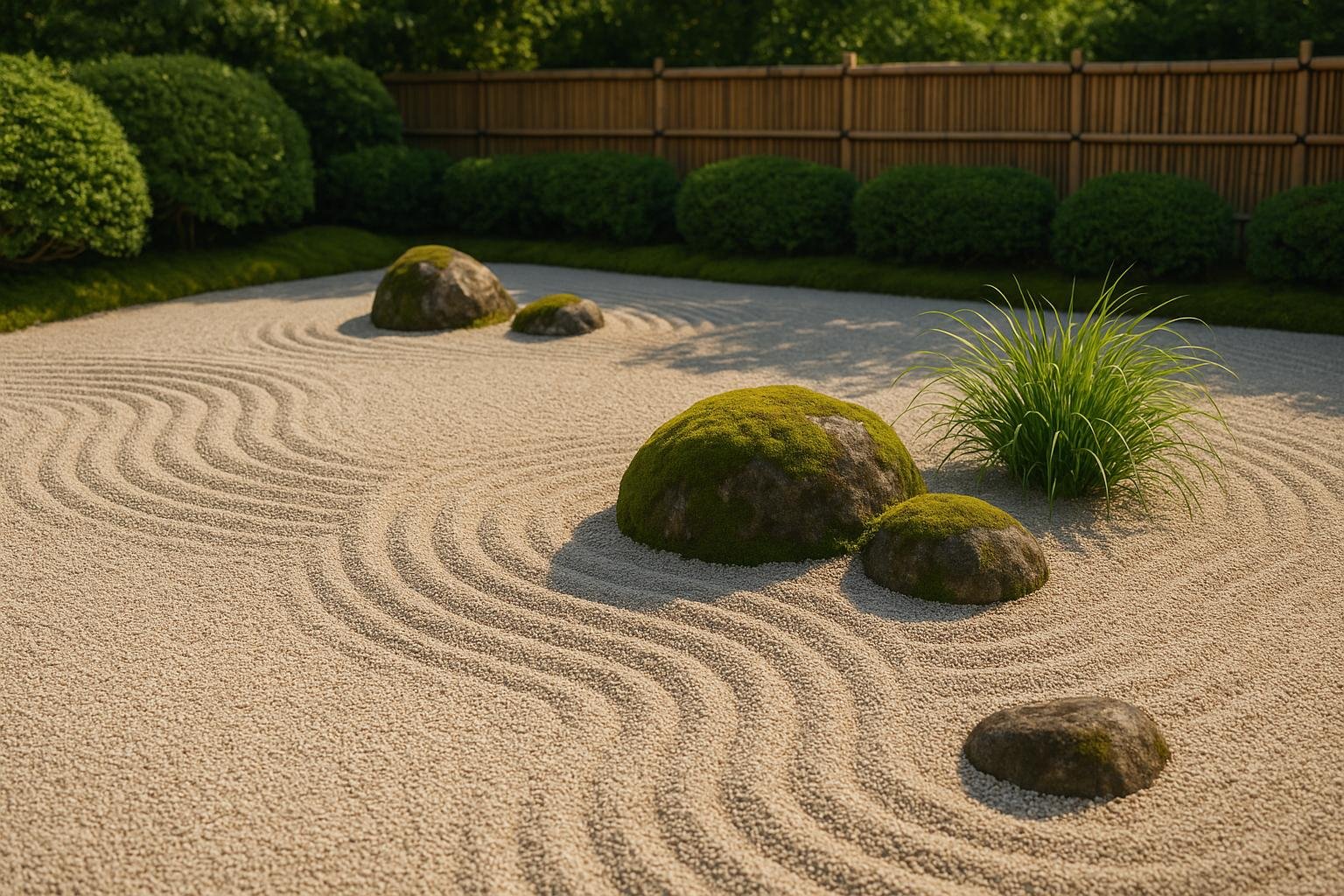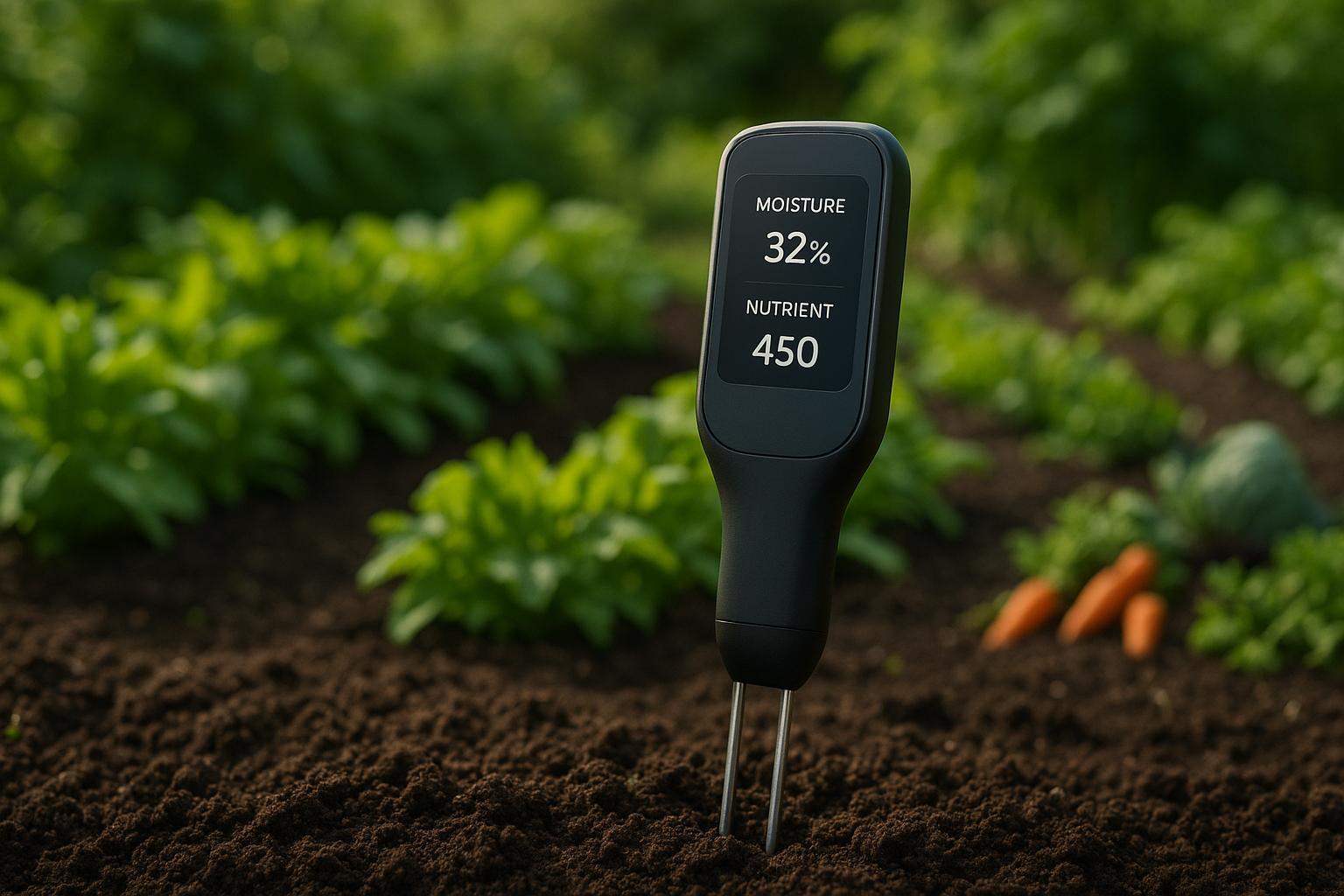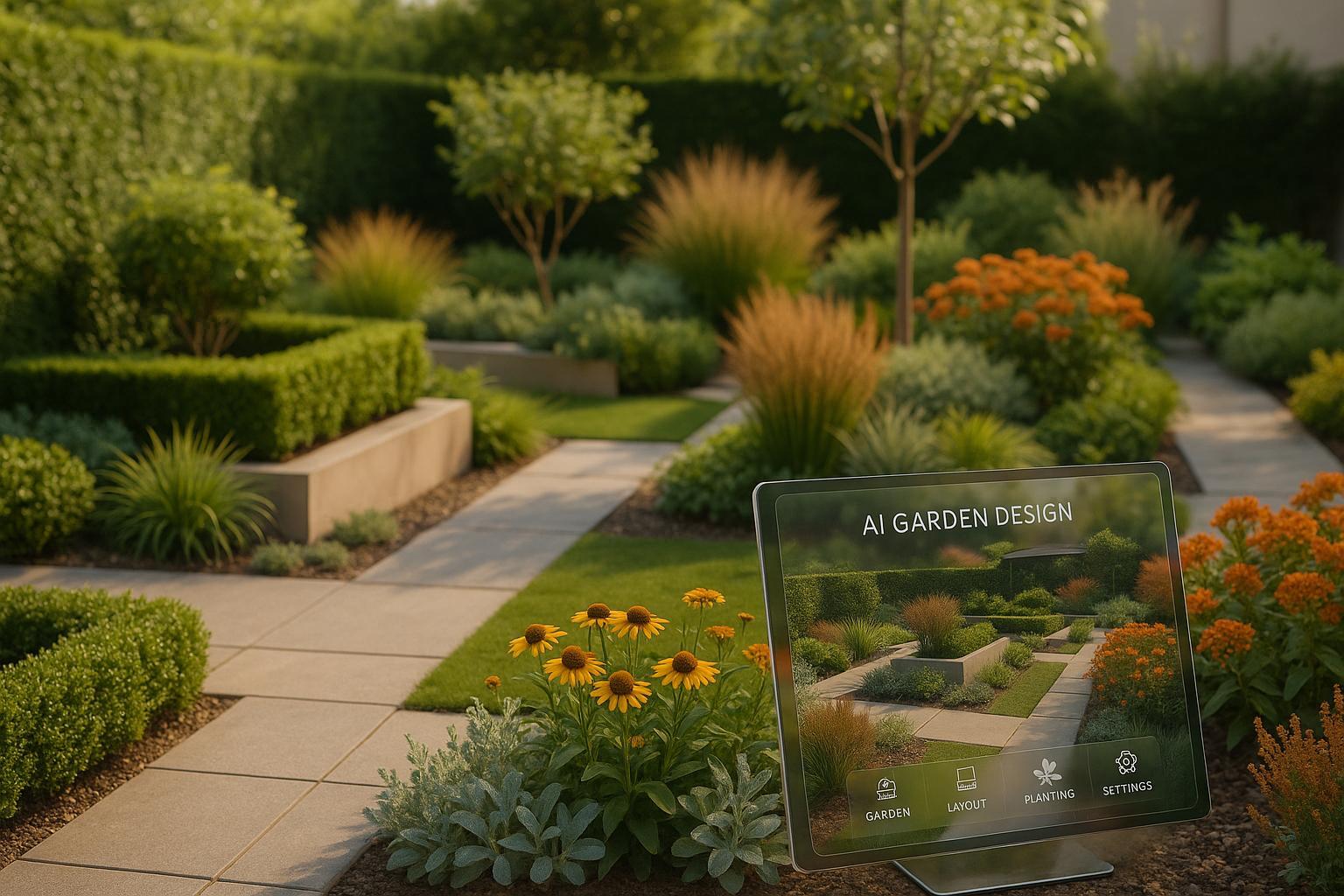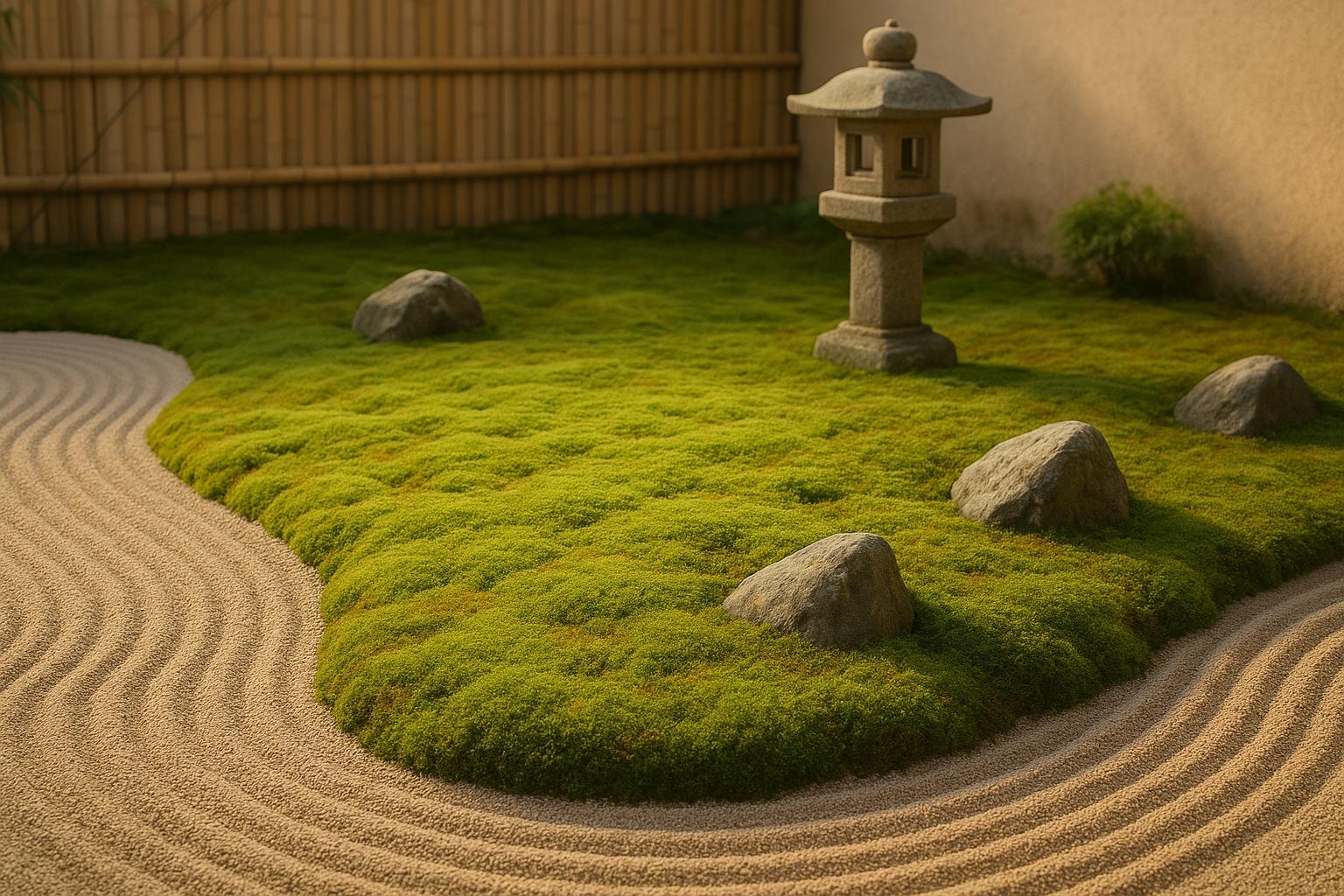Ultimate Guide to Weed Control in Zen Gardens

Weeds can ruin the peaceful look and feel of Zen gardens. They disrupt clean gravel lines, invade stone paths, and compete with plants for resources. But keeping your garden weed-free doesn’t have to be overwhelming. Here’s how you can maintain harmony:
- Prevent weeds by using barriers like landscape fabric and thick gravel layers.
- Remove weeds naturally through hand weeding, which doubles as a calming activity.
- Use mulch (organic or inorganic) to block sunlight and suppress growth.
- Design smartly with raised beds, defined edges, and proper gravel depth.
- Stay consistent with regular checks and seasonal maintenance.
How to Weed in 4 Easy Steps + Motivation | Our Japanese Garden Escape

Weed Problems in Zen Gardens
Zen gardens come with their own set of challenges when it comes to weeds. Their unique design and maintenance practices often create conditions that unintentionally encourage weed growth. Knowing how these factors play a role is crucial for keeping these serene spaces weed-free.
How Zen Garden Features Affect Weed Growth
The classic elements of Zen gardens - gravel, sand, and carefully positioned rocks - can make weed control tricky. While these materials seem unfriendly to weeds, they can actually create opportunities for them to thrive.
- Gravel and sand surfaces might look like they wouldn't support plant life, but they can trap soil and organic debris, creating tiny pockets where weeds can germinate. Rain and wind often deposit this debris into gaps, giving weeds the foothold they need [3].
- The thickness of the gravel or sand layer is a major factor. Deeper layers, sometimes supported by a base of sand or concrete, are better at preventing weeds from breaking through. Shallow layers, however, provide less of a barrier, allowing persistent weeds to find their way in [2].
- Rock placement also matters. Without a weed barrier underneath, rocks alone won't stop weeds from sprouting in the spaces between them. Windblown seeds and debris can easily settle in these gaps, leading to growth [3].
Even routine maintenance can unintentionally encourage weeds. The meditative act of raking, for example, can disturb the gravel or sand surface. This might expose buried weed seeds, giving them the chance to germinate [3]. While raking is essential for maintaining the garden's look, it needs to be done with care to avoid stirring up potential problems.
Light-colored gravel or rocks add another layer of difficulty. They make even the smallest weed growth stand out, disrupting the peaceful, minimalist aesthetic [4]. And where the Zen garden meets other planted areas, differences in moisture and soil often make these edges hotspots for weeds [2].
These design features and maintenance habits create an environment where weeds can take hold if not carefully managed, setting the stage for understanding the types of weeds that pose the biggest challenges.
Common Weeds Found in Zen Gardens
In Zen gardens, even a single weed can ruin the carefully crafted sense of harmony. Identifying the most common culprits is the first step to effective control.
- Perennial weeds are the most difficult to manage because they come back year after year. Their deep root systems can push through gravel and reach the soil beneath, making them especially hard to eliminate [5].
- Annual weeds, while less persistent, can spread quickly if not dealt with. Some species are incredibly prolific, producing tens of thousands of seeds from a single plant [5].
Certain weeds, like bindweed, are particularly tough. Bindweed seeds, for example, can stay viable in the soil for decades - up to 50 years in some cases [5]. This longevity makes them a long-term threat to the garden's tranquility.
In Zen gardens, where every detail matters, even a small weed infestation can disrupt the overall design and peaceful atmosphere [4]. These unwelcome invaders require careful attention and consistent management to maintain the garden's intended balance and serenity.
Designing Your Garden to Prevent Weeds
Weeds can disrupt the serene atmosphere of a Zen garden, but thoughtful planning and design can minimize their presence. By incorporating smart strategies from the start, you can save yourself hours of maintenance while maintaining the clean, tranquil aesthetic that defines these spaces.
Installing Weed Barriers and Ground Covers
The key to preventing weeds starts below the surface. Using landscape fabric as a barrier blocks sunlight and prevents weed seeds from sprouting. When choosing fabric, you’ll find two primary options: woven and non-woven. Woven fabrics are stronger and more durable, making them perfect for walkways or areas with heavy stone. Non-woven fabrics, on the other hand, allow for better water flow and breathability, which is essential for areas with plants [9].
Proper installation is critical. Before laying the fabric, clear the area of weeds and debris [6]. Overlap the fabric by at least 6 inches at the seams to prevent gaps, and secure it with landscape staples or pins every 3–4 feet. This is especially important in windy areas to keep the fabric firmly in place [6].
In Zen gardens, the depth of gravel or sand plays an important role. Traditional Japanese temple gardens often use gravel layers between 0.8 and 2 inches deep, with particle sizes around 0.35 inches, particularly for spaces under 1,100 square feet [8]. However, for stronger weed prevention, a thicker gravel layer - supported by a sand or concrete base - provides a more effective barrier [2].
A review in June 2025 highlighted that precise installation and securing the edges are essential for maintaining weed suppression. Regular upkeep is just as important. Check periodically for exposed areas where weeds might creep through, and address these spots immediately [6]. Refresh the top layer of gravel as needed to keep the garden looking pristine and to maintain its weed-blocking properties [6].
Layout Changes That Stop Weeds
Beyond barriers, the layout of your garden can also reduce weed growth. Raised beds are an excellent choice - they not only limit weed intrusion but also improve drainage, which benefits many Zen garden plants.
Defined borders are another effective design element. Using edging materials like galvanized steel or wood creates clear boundaries that prevent gravel from spilling and weeds from creeping in [7]. These borders also make maintenance easier by providing clean lines for trimming.
Sparse planting is a cornerstone of Zen garden philosophy, and it has the added benefit of reducing weed pressure. Fewer plants mean fewer opportunities for weeds to take hold. When incorporating plants, space them carefully to allow for easier monitoring and maintenance.
Gravel paths require special attention. For effective weed prevention, excavate 2–3 inches for the pathway base, then lay a foundation of tamped-down stone pack topped with landscape fabric [7]. This layered approach is far more effective than simply spreading gravel over bare soil.
Pay close attention to transition zones - where your Zen garden meets other landscaped areas. These edges are often hotspots for weeds due to differences in moisture and maintenance routines. Adding wider gravel borders or extra barriers in these areas can help keep invasive weeds out.
The beauty of these design strategies lies in their subtlety. Visitors will admire the peaceful arrangement of stones, gravel, and thoughtfully placed plants, likely unaware of the careful planning that keeps weeds at bay. By implementing these preventative measures, your Zen garden stays true to its meditative purpose while requiring less upkeep over time.
🚀 Ready to Reinvent Your Garden?
Join thousands of homeowners who have transformed their gardens using our AI design tool. Upload one photo to explore endless possibilities.
Get your AI garden designs →Manual and Natural Weed Removal Methods
Keeping your Zen garden free of weeds without using chemicals aligns perfectly with its tranquil and meditative essence. By opting for natural methods, you can maintain its harmony while effectively managing unwanted growth.
Hand Weeding Techniques
Hand weeding allows you to focus directly on removing unwanted plants without disturbing the ones you want to keep [11].
For the best results, weed after a rainfall or lightly water the soil beforehand to loosen the roots [11]. Younger weeds are easier to remove entirely, so tackle them early [11]. Work systematically, section by section, to ensure thorough coverage. For instance, at the Harn Museum's dry landscape garden, staff carefully walk around each rock island before raking, removing debris and weeds without disrupting untouched areas [10]. Always dispose of weeds immediately to avoid spreading seeds [11]. After clearing an area, apply a thin layer of mulch to suppress future growth and help the soil retain moisture [11].
To make the process even more efficient, combine hand weeding with specialized tools.
Tools That Won't Disturb Your Garden
The right tools can make weeding easier while preserving the untouched beauty of your Zen garden. Short-handled tools, like hori hori knives and kana hoes, are perfect for precise tasks, while long-handled tools can save your back and knees during longer sessions [13].
For deep-rooted weeds, a Corona Hori Hori Knife (around $20) is a great choice for digging out stubborn taproots [13]. Other handy options include the BlueArrowExpress Kana Hoe 217 ($18) and the Grebstk Crack Weeder ($13), which are effective in various conditions without disrupting the surrounding area [13].
Japanese-made tools are particularly popular among gardeners for their quality and performance. For example, the Japanese Hand Weeder ($17.99) has a 4.7-star rating from 311 reviews, while the FUJIWARA Japan Nejiri Gama Hoe ($12.99) boasts a 4.6-star rating from 1,469 reviews [12]. Depending on your garden's needs, you might also consider tools like weeding forks for tackling deep roots or scuffle hoes for cutting through surface roots and turning weeds back into the soil [13].
These tools are excellent for keeping your garden in top shape while minimizing disturbances.
Regular Check-ups and Maintenance Schedule
Consistency is the secret to keeping weeds under control and maintaining your garden's serene environment. Weekly spot-checks can prevent small issues from turning into bigger problems [14]. Spend just 15 minutes a day or 1–2 hours a week on weeding to stay ahead [16]. Removing weeds before they flower or set seed significantly reduces their chances of returning [16].
Focus on areas prone to weed growth, such as edges, spots near water sources, or areas where gravel is thinner [15]. Extract weeds as soon as you notice them, making sure to remove the entire root system [15]. Additionally, avoid walking on raked gravel surfaces unnecessarily to preserve the garden's refined design [10].
sbb-itb-4d6a8dd
Using Mulch to Stop Weeds
Mulch plays a dual role in weed control and enhancing the serene look of a Zen garden. Acting as a shield, it blocks sunlight from reaching weed seeds while also preserving soil moisture around your plants [17]. The trick lies in choosing the right mulch and applying it correctly to maintain your garden’s peaceful aesthetic. Below, we’ll break down mulch options to help you decide what works best for your Zen garden.
Organic vs. Inorganic Mulch Options
Choosing between organic and inorganic mulch depends on your garden’s needs and how much maintenance you’re willing to handle.
Organic mulches naturally break down over time, enriching the soil in the process. Allison Bailey, an Agriculture and Natural Resources Agent at the University of Georgia, notes:
"As it decomposes, organic mulch adds nutrients (organic matter), enhances soil structure, and supports beneficial microorganisms." [21]
- Wood chips are a great option for Zen gardens, offering long-lasting weed control while decomposing slowly [17].
- Shredded bark breaks down more quickly, nourishing the soil faster.
- Pine bark adds a decorative touch and slightly acidifies the soil, which can benefit certain plants [17].
- Straw, though lightweight and quick to decompose, works well in areas where faster breakdown is desired [17].
Inorganic mulches, such as gravel, rocks, or landscape fabric, provide durable weed control with minimal upkeep. These materials fit seamlessly into a Zen garden’s minimalist design [20]. Gravel and rocks, in particular, not only suppress weeds effectively but also enhance the visual appeal of your garden space [17]. Opt for stones smaller than half an inch to improve water conservation and weed suppression [21].
| Mulch Type | Advantages | Considerations |
|---|---|---|
| Organic | Improves soil health, retains moisture, supports beneficial organisms | Requires regular replenishment, may attract pests |
| Inorganic | Long-lasting, low maintenance, excellent weed control | Doesn’t enrich soil, may raise soil temperatures |
Your choice will depend on factors like soil needs, maintenance preferences, and climate. For example, organic mulch is better at retaining moisture in hot, dry climates, while inorganic mulch can help manage excess moisture in cooler, wetter areas [20][21].
Once you’ve chosen your mulch, proper application is key to getting the most out of it.
How to Apply Mulch for Best Results
Applying mulch correctly ensures effective weed control and keeps your Zen garden looking pristine. Begin by clearing out any existing weeds to prevent them from growing through the mulch layer [17].
Depth is crucial for weed suppression. For coarse-textured mulches like wood chips, spread the layer about 4 inches deep. For finer mulches, stick to a depth of around 2 inches to avoid compaction and ensure good airflow [19].
Placement matters, too. Keep mulch a few inches away from plant stems to prevent rot and pest issues. Spread it evenly around plants, maintaining the garden’s clean and balanced look [17][14]. The idea is to create a protective barrier that complements your garden’s design without overpowering it.
For added weed control, you can use landscape fabric beneath the mulch. Overlap the fabric pieces and secure them tightly, making sure no soil is exposed on top, as this could allow weeds to sprout [19]. Then, apply a thin mulch layer - about 1 inch deep - over the fabric to shield it from sunlight and maintain coverage [19].
Regular upkeep is essential to keep your mulch effective throughout the year. Organic mulch should be refreshed annually to maintain its appearance and functionality [18]. Lightly rake the mulch to aerate it and prevent it from forming a dense, compact layer [18]. If any weeds manage to sprout, they can be easily removed by hand or with a hoe [19].
With periodic replenishment and mindful care, your mulch will continue to protect your Zen garden while preserving its tranquil beauty. This attention to detail aligns perfectly with the mindful, intentional approach that defines Zen gardening.
Long-Term Care and Maintenance Practices
Keeping a Zen garden free of weeds calls for consistent care and attention, turning everyday maintenance into a calming, meditative experience [22][14]. The secret to effective long-term weed control lies in establishing seasonal routines and adapting them based on careful observations. This approach helps address minor weed problems before they grow into larger issues, allowing you to fine-tune your efforts as the seasons change.
Seasonal Tasks to Control Weeds
Seasonal care plays a crucial role in managing weeds. Tasks like refreshing mulch and fixing barriers during late winter, followed by weekly checks in spring and summer, work to keep weed growth under control. Late winter and early spring are particularly good times to inspect and repair garden fabrics, fill in gaps, and refresh mulch layers [1]. During these cooler months, lightly raking gravel areas can also prevent soil buildup, which is a prime spot for weeds to take root.
As the weather warms in spring and summer, weekly inspections become essential. Pay close attention after rainfall, as weeds tend to sprout quickly in damp conditions. Remove any new growth promptly to prevent weeds from producing seeds. In the fall, focus on clearing out any lingering weeds and adding mulch to areas where it has thinned out. This ensures your garden is well-prepared to face the winter season.
Tracking Problems and Adjusting Methods
In addition to regular weeding and design-focused measures, tracking weed patterns can greatly improve your garden care. Make it a habit to note where weeds appear, what types they are, and which removal methods work best [23]. Understanding how weeds spread - whether by seeds or underground roots - can help you choose the most effective techniques and timing for removal.
As Alexandra Campbell from The Middle-Sized Garden advises:
"If you pick out a weed every time you see one, you'll make a big difference to your garden." [24]
Incorporating ideas from Integrated Pest Management (IPM) can also enhance your strategy. This method blends biological, mechanical, and natural techniques to manage weeds while preserving your garden's peaceful atmosphere. Adjusting elements like mulch depth, drainage, plant spacing, and irrigation can create conditions that favor your desired plants over weeds.
How AIGardenPlanner Helps with Weed Control

To complement your hands-on efforts, digital tools like AIGardenPlanner can streamline your maintenance routine. This platform tailors its guidance to your local climate, soil quality, and garden conditions, offering personalized tips for long-term weed control [25]. It creates customized schedules for seasonal tasks, ensuring you stay on top of essential maintenance. The AI Plant Advisor even suggests plants that naturally suppress weeds, such as those with dense growth or ground-covering traits, helping your garden flourish while reducing weed opportunities.
For persistent weed problems, AIGardenPlanner offers strategic solutions, like adjusting plant spacing or redesigning areas to include extra weed-prevention measures - all without compromising the serene aesthetic of your Zen garden. From weeding and pest management to optimizing irrigation and selecting drought-resistant plants, the platform provides comprehensive guidance to help you cultivate a garden that’s not only beautiful but also less inviting to unwanted weeds.
Conclusion: Maintaining a Weed-Free Zen Garden
Creating and sustaining a weed-free Zen garden requires a blend of thoughtful planning, gentle care, and consistent upkeep. By combining intentional design, regular hand-weeding, strategic mulching, and seasonal attention, you can preserve the peaceful essence of your garden while keeping invasive weeds at bay [26].
At the heart of effective weed control lies prevention. According to the UC IPM program:
"Preventing new weeds from establishing and preventing existing weeds from producing seed are the most cost-effective methods of weed management." [27]
This aligns perfectly with the principles of Zen gardening, where maintaining harmony and minimizing disruption is essential.
A balanced approach is crucial. Research from Washington State University highlights this:
"An integrated approach to weed management uses a combination of cultural, physical, biological, and chemical methods to provide the best possible weed management in each situation." [28]
For your Zen garden, this might mean using weed barriers, applying 2–4 inches of organic mulch after clearing weeds, and committing to a gentle, regular hand-weeding routine to stop weeds from seeding.
Applying mulch at the right time and conducting frequent inspections can significantly reduce future weed growth [19]. Hand-pulling weeds, done carefully, not only minimizes soil disturbance but also transforms the act into a calming, meditative practice [11].
To complement these efforts, consider integrating modern tools like AIGardenPlanner's AI Plant Advisor. This tool can suggest plants with natural weed-suppressing properties and provide customized maintenance schedules, blending technology with tradition without disrupting the serene aesthetics of your Zen garden.
Ultimately, maintaining your garden’s tranquility comes down to steady, mindful care. Short, weekly inspections are far more effective - and less overwhelming - than sporadic, intensive weeding sessions. With this approach, your Zen garden becomes more than a space; it transforms into a living meditation, where every act of care nurtures both the garden’s beauty and your inner peace.
🎨 Visualize Your Dream Garden Today!
Transform any outdoor space into a professional landscape design in minutes. Just upload a photo, choose your style, and let our AI do the rest.
Start your garden transformation now →FAQs
What are the best natural ways to remove deep-rooted weeds from a Zen garden?
When it comes to getting rid of deep-rooted weeds in a Zen garden, the goal is to keep things gentle and environmentally friendly. One of the easiest ways to start is by moistening the soil. This softens it up, making it simpler to pull out weeds by hand - roots and all. If you’re dealing with especially stubborn weeds, a hand fork can be a lifesaver. Use it to carefully loosen the soil around the rootball, so you can remove it completely.
Another no-fuss, chemical-free trick is pouring boiling water directly onto the weeds. This method works by killing the plants all the way down to their roots. Not only do these approaches help keep your Zen garden looking peaceful and tidy, but they also stay true to its core values of harmony and respect for nature.
What’s the best way to stop weeds from growing where my Zen garden meets other landscaped areas?
To keep weeds at bay along the edges of your Zen garden, combine physical barriers with regular upkeep. Begin by placing weed barrier fabric or landscaping fabric underneath the gravel or sand. This layer acts as a shield, preventing weeds from sprouting. To further protect the edges, use defined borders like garden edging kits or natural materials such as stones or wooden planks. These not only keep the garden materials in place but also make it harder for weeds to creep in.
For maintenance, pull out any stray weeds as soon as they appear and periodically refresh the gravel, sand, or mulch. Consistent care will help preserve the peaceful, weed-free atmosphere of your Zen garden.
What are the advantages of organic vs. inorganic mulch in a Zen garden, and how do I select the best option?
Mulch can transform your garden, but it’s essential to choose the right type for your needs. Organic mulch, like wood chips or bark, breaks down over time, enriching the soil with nutrients, retaining moisture, and helping to keep weeds at bay naturally. On the other hand, inorganic mulch, such as stones or rubber, doesn’t decompose but offers long-term weed control and moisture retention. Plus, it provides a neat and decorative appearance.
When deciding on mulch, consider your garden’s overall style, soil requirements, and how much upkeep you’re willing to handle. Organic mulch is ideal if you want to boost soil health and nurture your plants, while inorganic mulch suits low-maintenance gardens with a more polished, modern look. Think about the harmony and practicality of your space to find the perfect match for your garden.
Related posts
Related Articles

Top 7 Soil Sensors for Moisture and Nutrient Tracking
Explore the top soil sensors for monitoring moisture and nutrients, enhancing your gardening efficiency and plant health.

How AI Adjusts Garden Styles Instantly
Unlock the power of AI in garden design with instant customization, eco-friendly plant suggestions, and professional-quality layouts tailored to your space.

Seasonal Garden Design: Lessons from Chinese Practices
Explore seasonal garden design inspired by Chinese practices, blending nature and philosophy for beauty throughout the year.

How AI Picks Garden Color Schemes
AI tools transform garden design by analyzing photos to create customized color schemes, considering local climate and personal preferences.

Ultimate Guide to Moss Cultivation for Zen Gardens
Learn how to cultivate moss for Zen gardens, ensuring a tranquil atmosphere with minimal maintenance and tailored care techniques.

Guide to Choosing the Right Location for Your Vegetable Garden
Learn how to choose the best location for your vegetable garden with this comprehensive guide. Factors such as sunlight, water, and soil quality are discussed, as well as maintenance tips.